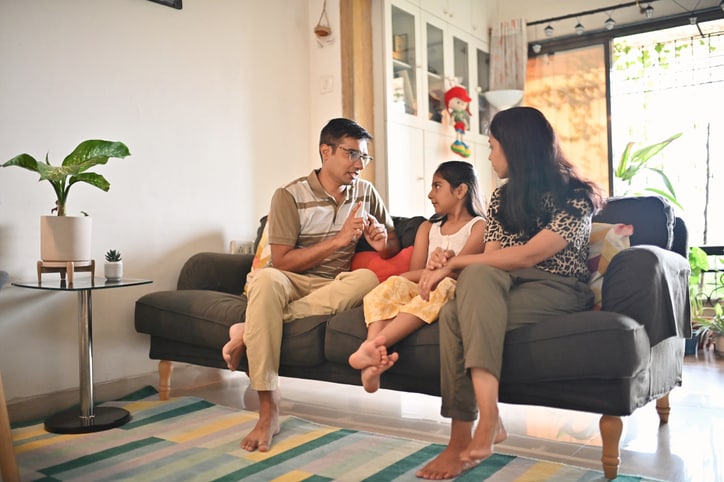This is not your mother’s bully.
So long playground teasing and taunting, bullying has entered cyberspace, ridiculing kids in the safety of their bedrooms and smartphones. Recently, it replaced stranger danger as parents’ worst fear, according to a recent Care.com survey. We spoke with child psychologists Drs. Laurie and Fred Zelinger, a husband and wife team with more than 70 years of combined experience working in schools, to get their insight into how to communicate better with our children, whether they are being bullied or they are the bully.
The Zelingers’ Top 5 Tips for Dealing with Bullying in Your Family:
1. Sit side-by-side, and start with a statement. “There’s been some research about how boys and men communicate better when they’re sitting next to each other as opposed to sitting opposite each other,” Dr. Laurie Zelinger points out. Try to find times when you are sitting close enough to your child without the pressure of time to get something done, and open up communication about bullying with a casual statement instead of a question; a statement feels less confrontational to the child. “Something simple, like, ‘Wow, looks like you’re really thinking about something right now, ‘” Dr. Laurie Zelinger says. You never know where it might lead.
2. Use the power of positive reinforcement. Many parents think that if they punish their child for bullying, it will solve the problem. But Dr. Fred Zelinger disagrees. “Bullies don’t go away because they’re disciplined. If your child is bullying, try to catch him doing something good, like playing with a sibling, or sharing, or generally being kind to someone else, and positively reinforce that behavior. It’s more powerful.” The Zelingers strongly believe in positive reinforcement, adding that it works best in terms of promoting better behavior for bullies as well as bullying victims.
3. Watch for signs. Children who are bullied often exhibit signs of anxiety that something might be going on in their school lives. Dr. Laurie Zelinger notes: “Lots of times it’s avoidance, feeling sick, trouble going to sleep at night, changes in eating patterns — these are the things that change in children when they’re anxious or worried. They also may become regressive — they may talk in baby talk, or there might be an increase in clinginess.”
>> For more details about signs of anxiety in your child, read Signs Your Child is a Bully or Being Bullied.
4. Stay active and involved, especially when it comes to technology. With cyberbullying on the rise, parents need to be extremely mindful of what their kids are doing — offline and online. “The truth of the matter is, we have to understand the technology that they’re using,” Dr. Fred Zelinger advises. “Know about texting language, instant messaging, social media and the internet. You can’t be ignorant about it if you have kids.” Keep your computers and internet access in a central location. Most importantly, talk to your kids about acceptable online behavior, and how to avoid being a bystander in online bullying.
>> For more information, check out our cheatsheet on supervising your child online.
5. Be ready for anything. Discovering that your child is involved in bullying can be the toughest news to swallow as a parent. According to Dr. Fred Zelinger, readying yourself and accepting it is the most important step to opening communication lines. “A lot of parents [of bullies] will say, ‘Not my kid, that’s just not possible, ‘” he says. If you keep denying it, what’s the kid going to think? Your denial is tacitly approving his behavior.”
Not all bullies bully for the same reason; having the difficult conversations and understanding why they bully is critical to getting them to stop. Dr. Fred Zelinger adds, “Don’t be afraid to talk about the information you’ve received, but don’t lecture and make threats. Say, ‘I’ve heard that you have done this … let’s talk about it and figure out what’s happening.” Listen to answers, don’t interrupt with moralizations, threats or demands. Getting the child to talk is your primary goal. Offering to help the child come up with other solutions as an alternative to bullying is really important.”
>> For more strategies, read our tips on what to do if your child is the bully.
Did you know that POMS stands for “Parent Over My Shoulder” in text/IM speak? For more tips from the Zelingers on managing bullies and staying involved in your kids’ lives, read the full interview below.
What strategies can parents use to help their kids with bullying?
FZ: The strength to be resilient in the face of some adversity – either bullying, or anxiety, or anything like that – comes from reinforcing a child’s personality values and character. So if the kid is sharing, or doing pro-social things, acting in a courageous way, or handles anxiety, we have to notice those things. Reinforcement of “catching them being good” is really important. It teaches kids about strength of character, and being able to manage the things that are coming their way. If your child is internally strong enough, he’ll be able to manage facing a bully.
LZ: It’s important to do this for the bully too. But it’s important to point out that a child who is bullying may need other skills to be developed. So that’s why you have to let him know that he’s not going to get everything he wants by bullying, but that he might be able to get attention — good attention — for the prosocial behaviors that may be underdeveloped (sharing, being kind, helping somebody else). Sometimes reading a book about bullying can open up a conversation about it. Look at the pictures and ask the child to comment on them – it may lead to a conversation about something that the child may have experienced.
I do a lot of mirror work with kids, and I tell them, stand up straight, puff your chest out, keep your shoulders back, stand confident. A lot of it has to do with the physical message you send off to your peers.
What advice can you give to parents whose children might be the bullies?
FZ: First, you have to accept that your child may be a bully. A lot of parents will say, not my kid, that’s just not possible. If you keep denying it, what’s the kid going to think? Your denial is tacitly approving his behavior. It’s important that you be open to hearing about things. Since I know punishment doesn’t work, I do know that reinforcing positive behavior, catching the kid doing something good, and positively reinforcing that behavior, is more powerful.
Not all bullies bully for the same reason. And if you don’t understand the “why” of a behavior, it gives you less latitude in terms of managing it. Some bullies bully because they’re anxious, and they want to cover up their own anxiety. Some bullies bully because they’re bigger and stronger, and they just have to prove themselves in that way. If you can understand the reasons why your child is bullying, it dramatically increases the success rate of being able to help your child learn not to.
What are some signs that your child may be a victim of bullying?
FZ: Kids who are being bullied often exhibit signs. While being in communication with the schools is essential, most bullying doesn’t happen in the classroom. It happens in hallways, recess, bus, playground, cafeterias.
LZ: You’ll see avoidance. Kids won’t want to go to school. They’ll want to avoid the place where they think they’ll run into bullying. So lots of times in the morning, a child might pretend that they’re sick, or they might actually feel sick and won’t want to go to school. If you see that become a pattern, then you can figure out something’s going on that’s raising their anxiety. It could be bullying. It could be a fear of being exposed as not smart, or of a teacher who yells. But that’s part of what you’ll have to figure out. Lots of times it’s avoidance, feeling sick, trouble going to sleep at night, changes in eating patterns – these are the things that change in children when they’re anxious or worried. They also become regressive, they’ll talk in baby talk, or there might be an increase in clinginess. Those are all anxiety symptoms.
How can parents stay plugged into their kids’ lives, without hovering?
FZ: Knowing what a child is doing on a computer is important. We have computers in a central location in the house, not in our children’s rooms. We believe it should not be in a private location. We should be able to walk by and see what they’re doing.
LZ: By the same token, if we’re talking about computer use, I think it’s also important for a parent to know all of the cryptic internet abbreviations. I recently just learned that POMS, for example, is Parent Over My Shoulder, which means that even if you happen to be “hovering,” nothing meaningful will be said in the next few minutes while you’re around.
FZ: The truth of the matter is that we have to understand the technology that they’re using. And I think it’s important that people talk about the implications of this technology. Texting is a really big issue, because it’s happening in classrooms now. Schools are probably going to end up having to ban phones in the classroom. I feel like I should probably tell my kid that there’s no secrets in our world, so if I go on the computer and I see the kinds of things you’re working on and I don’t approve of it, we’ll talk about it. Or I need to know what kind of messages are going back and forth. Laurie says a very important piece of the communication puzzle is listening to our children while we’re carpooling.
LZ: We raised four boys, and boys don’t talk as much as girls. So if I was picking them up from school or taking them to a soccer game and I had a couple of kids in the car, I would just turn the radio down and just listen. Because they would talk amongst themselves, even though they knew I was there, there was this implicit sense that they were just communicating with their friends. That’s how I learned a lot of information. But I’d never interrupt. I would just listen to see how much information I could gather, and that would tell me if it was something that I would need to get on my radar, or if it was something pretty typical of my child.
FZ: There’s more information in the environment if you just listen and pay attention. Too often we get caught up in our own stuff – work, dinner, bedtime, cleanup – that we become more organized around responsibilities than we do about listening. So I think it’s important that you talk to your kid, listen to your kid, if you notice any changes in behavior, temperament, or anything else – then you know something’s happening – they do give off vibes.
What tips do you have for parents who are having trouble connecting with their kids about how they’re feeling?
LZ: There’s been some research about how boys and men communicate better when they’re sitting next to each other as opposed to sitting opposite each other. Like men at a bar, or sitting side by side at a game, or in a car. They do a lot more communicating that way. I’ll recommend to parents who want to communicate better to start with a statement. Maybe something that will make a kid laugh. Or something like, “Wow, looks like you’re really thinking about something right now.” That tends to open up a child. Or, “That was so hard to do. I can imagine that took a lot of courage.” Making a statement that may capture what a child is feeling is more effective than a question sometimes. It’s something that lets them know that you are attuned to them, but you’re not demanding an answer, which makes it much easier for them to respond.






